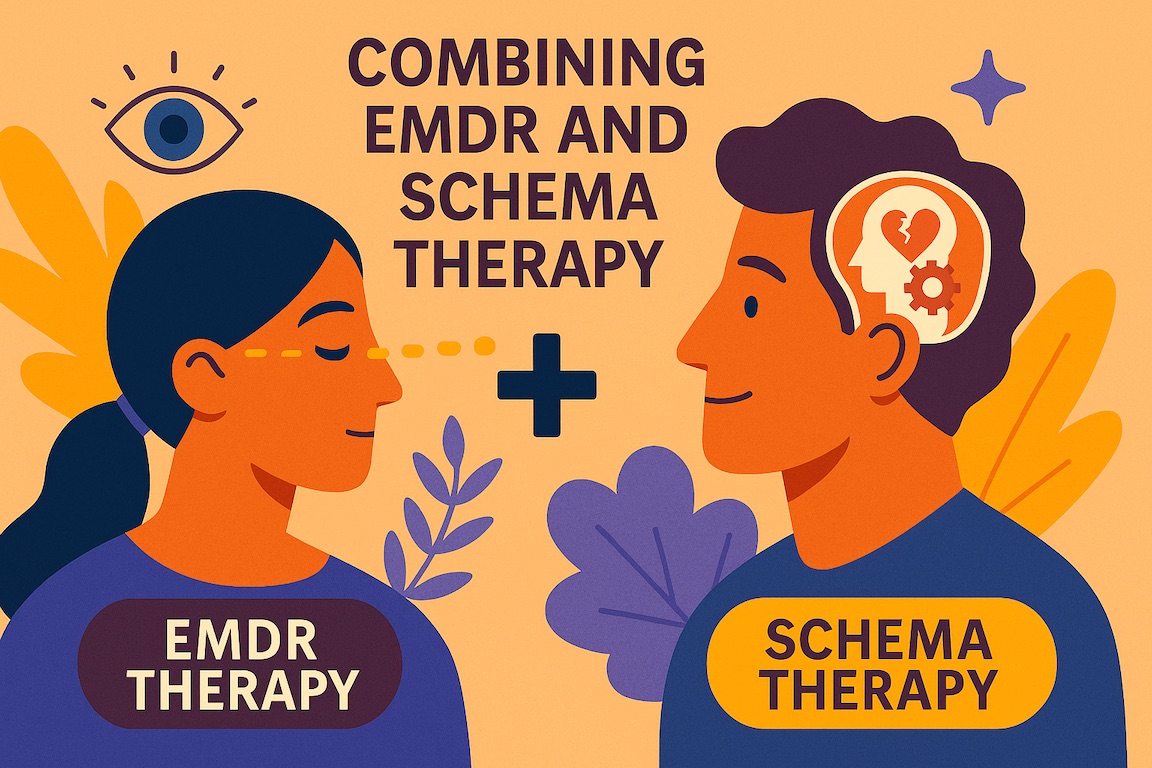What is EMDR Therapy?
Eye Movement Desensitization and Reprocessing (EMDR) therapy is a structured, evidence-based psychotherapy designed to help individuals heal from trauma, distressing memories, and negative self-beliefs. Developed by Francine Shapiro, EMDR involves guided eye movements, tapping, or auditory tones, to activate the brain’s natural healing mechanisms, allowing clients to manage traumatic experiences in a less distressing way. By desensitizing emotional triggers and restructuring maladaptive thought patterns, EMDR helps reduce symptoms of Post-Traumatic Stress Disorder (PTSD), anxiety, and other trauma-related conditions, promoting emotional resilience and adaptive coping. Schedule a free 15-minute consultation with the experienced therapists at Balanced Mind of New York to learn more.
What is Schema Therapy?
Schema therapy is an integrative psychotherapy that combines cognitive-behavioral, attachment, psychodynamic approaches, and Gestalt therapy to address deep-rooted maladaptive schemas. Schemas are negative core beliefs developed in childhood that shape patterns of thinking, feeling, and behaving. This treatment approach was developed by Jeffrey Young and focuses on identifying and restructuring these schemas while also addressing unmet emotional needs. Through techniques such as cognitive restructuring, experiential exercises, and parts work (e.g., addressing the “inner child”), therapists trained in schema therapy help clients break free from self-defeating patterns, improve emotional regulation, and develop healthier relationships with themselves and others.
How Are EMDR and Schema Therapy Alike?
EMDR and Schema therapy share several foundational similarities despite their different methodologies. Both therapeutic approaches recognize the profound impact of early childhood experiences on adult functioning and address deeply ingrained patterns that originate from unmet core needs or traumatic experiences. While EMDR focuses on processing traumatic memories through bilateral stimulation to resolve “stuck” neural networks, Schema therapy identifies and works with maladaptive schemas or core beliefs. Both ultimately aim to restructure these embedded patterns that drive emotional distress and dysfunctional behaviors.
The therapeutic relationship is central to both EMDR and Schema therapy, with each emphasizing the importance of safety, validation, and attunement as prerequisites for healing. Additionally, both approaches incorporate elements of cognitive restructuring. EMDR accomplishes this through the installation of positive cognitions and Schema therapy does this through challenging negative schemas. These therapeutic approaches both acknowledge the importance of emotional and somatic experiences in comprehensive healing. Perhaps most significantly, both therapies recognize that transformation occurs not just through intellectual understanding but through corrective emotional experiences that help clients develop healthier ways of relating to themselves and others.
Benefits of Combining Schema Therapy and EMDR Therapy
Combining Schema therapy and EMDR therapy creates a powerful integrative treatment model that leverages the best aspects of both modalities to provide more comprehensive treatment. Schema therapy excels at identifying and understanding the maladaptive patterns (schemas) that develop from unmet childhood needs, while EMDR efficiently reprocesses the emotional intensity of traumatic memories that reinforce these schemas. When used together, the conceptual framework of the Schema therapy model helps target the most relevant memories for EMDR processing, making treatment more focused and efficient.
The Schema therapy concept of modes (emotional states like the Vulnerable Child or Punitive Parent) pairs naturally with EMDR’s ability to address different aspects of traumatic experiences. EMDR can be used to reprocess the emotional pain underlying specific modes, while Schema therapy provides context and understanding for the emotional shifts that occur during EMDR processing. This combination helps clients not only reprocess painful memories but also understand how these experiences created their core beliefs and emotional patterns.
Integration of these approaches also enhances emotional regulation capabilities. Schema therapy’s emphasis on limited reparenting provides the safe therapeutic relationship necessary for effective trauma processing, while EMDR’s bilateral stimulation techniques offer physiological regulation during emotional activation. Together, they create a balanced approach that addresses both the cognitive-emotional patterns and the neurobiological facets of psychological distress, potentially leading to more durable change and healthier patterns than either therapy might achieve alone.
For complex trauma, PTSD symptoms, and personality disorders (such as borderline personality disorder), this combined approach may be particularly beneficial. Schema therapy addresses the characterological traits and interpersonal patterns that develop from early life experiences and chronic trauma, while EMDR helps reprocess the specific traumatic memories that maintain these patterns. This integration of models allows EMDR clinicians to be responsive to clients’ needs, using Schema therapy techniques when clients need understanding and containment, and transitioning to EMDR when they’re ready to process specific memories. This flexibility creates a supportive and responsive treatment approach that can adapt to varying stages of healing.
How Do I Pay For Schema Therapy and EMDR Therapy?
Balanced Mind of New York is a private pay practice and does not accept insurance. We believe in providing individualized, high-quality care without the restrictions or limitations often associated with insurance-based treatment.
If you have out-of-network benefits, we’re happy to provide a superbill upon request, which you can submit directly to your insurance provider for potential reimbursement. Please consult your provider to understand your coverage and eligibility for out-of-network mental health services.
We accept Visa, MasterCard, Discover, American Express, and HSA/FSA cards.
Contact Balanced Mind of New York to learn more about your payment options and take the next step toward a healthier you.

